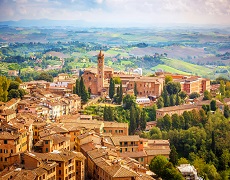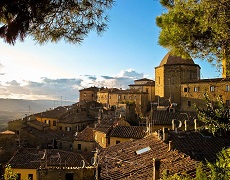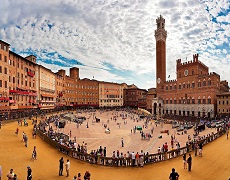Siena – San Gimignano – Volterra
Siena is one of the nation's most visited tourist attractions, a place you must visit. Siena is famous for its cuisine, art, museums, medieval cityscape and the Palio, a horse race held twice a year.
The Siena Cathedral (Duomo), begun in the 12th century, is a masterpiece of Italian Romanesque-Gothic architecture. Its main façade was completed in 1380. The original plan called for an ambitiously massive basilica, the largest then in the world, with, as was customary, an east-west nave. However, the scarcity of funds, in part due to war and plague, truncated the project, and the Sienese created a subdued version from the original plan's north-south transept. The east wall of the abandoned original folly of a nave still stands; through an internal staircase, visitors can climb for a grand view of the city.
The Piazza del Campo, the shell-shaped town square, unfurls before the Palazzo Pubblico with its tall Torre del Mangia which is one of Siena’s main symbol with its 102 meters height. Piazza del Campo is part of the site for the Palio, a medieval horse race. The square, itself is a great work of architecture, houses yet another important art museum, Ambrogio Lorenzetti's frescoes depicting the Allegory and Effects of Good and Bad Government and also some of the finest frescoes of Simone Martini and Pietro Lorenzetti.
The Palazzo Salimbeni, located in a piazza of the same name, was the original headquarters and remains in possession of the Monte dei Paschi di Siena, one of the oldest banks in continuous existence in Europe.
We will continue our journey to San Gimignano. This town has kept its medieval form and atmosphere, walking between these magnificent buildings you would feel like a time traveller.
Known as the Town of Fine Towers, San Gimignano is famous for its medieval architecture, unique in the preservation of about a dozen of its tower houses, which with its hilltop setting and encircling walls form "an unforgettable skyline". While in other cities, such as Florence, most or all of their towers have been brought down due to wars, catastrophes, or urban renewal, San Gimignano has managed to conserve fourteen towers of varying heights, for which it is known internationally. Within the walls, the well-preserved buildings include notable examples of both Romanesque and Gothic architecture, with outstanding examples of secular buildings as well as churches. The Palazzo Comunale, the Collegiate Church and Church of Sant' Agostino contain frescos, including cycles dating from the 14th and 15th centuries.
After we finished admiring this truly atmospheric town, why not visit on of the world’s best ice cream parlour and patisserie.
Volterra is a walled mountaintop town in the Tuscany region of Italy of which its history dates to before the 7th century BC and has substantial structures from the Etruscan, Roman, and Medieval periods.
Volterra's well-preserved medieval ramparts give the windswept town a proud, forbidding air that author Stephenie Meyer deemed ideal for the discriminating tastes of the planet's principal vampire coven in her wildly popular Twilight series. Fortunately, the reality is considerably more welcoming, as a wander through the winding cobbled streets attests. Just as other Etruscan town Volterra was built on a hill too, from the streets and squares you can catch a breath taking view to the surrounding vineyards and orchards.
Places to visit: Roman Theatre of Volterra , 1st century BC, excavated in the 1950s, Piazza dei Priori, the main square, a fine example of medieval Tuscan town squares. Palazzo dei Priori, the town hall located on Piazza dei Priori, construction begun in 1208 and finished in 1257.
Pinacoteca (Art Gallery) in Palazzo Minucci-Solaini. Founded in 1905, the gallery consists mostly of works by Tuscan artists from 14th to 17th centuries.
Volterra Cathedral, it was enlarged in the 13th century after an earthquake. It houses a ciborium and some angels by Mino da Fiesole, a notable wood Deposition (1228), a masterwork of Romanesque sculpture and the Sacrament Chapel, with paintings by Santi di Tito, Giovanni Balducci and Agostino Veracini. In the center of the vault are fragments of an Eternal Father by Niccolò Circignan




 Italian (IT)
Italian (IT)  English (UK)
English (UK)  Hungarian (Hungary)
Hungarian (Hungary) 

